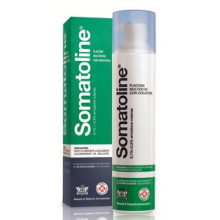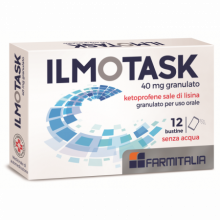VOLTALGAN * CUT FOAM 50G 3%
Therapeutic indications
Local treatment of painful and inflammatory conditions of a rheumatic or traumatic nature of the joints, muscles, tendons and ligaments.
Dosage and method of use
Adults and adolescents from 14 years of age: Apply VOLTALGAN skin foam 1-3 times a day. For each application, spray on the palm of the hand, depending on the size of the area to be treated, a circular mass of foam of 3-5 centimeters in diameter (equal to about 0.75-1.5 grams in weight), massaging gently until completely absorption. In case of iontophoresis treatment, the product must be applied to the negative pole. VOLTALGAN skin foam can also be used in combination with ultrasound therapy.After application, ask the patient to wash their hands, otherwise they will also be treated with skin foam. Warning: the product should only be used for short periods of treatment. If the product is needed for more than 7 days to relieve pain or if symptoms worsen, the doctor should re-evaluate the situation (see section 4.4).Children under 14:Insufficient data are available on efficacy and safety in children and adolescents below 14 years (see also section 4.3 Contraindications). Therefore the use of Voltalgan cutaneous foam is contraindicated in children under 14 years of age.Elderly people: The usual adult dosage may be used. How to use : Shake before using. With the can upside down, dispense the desired quantity by pressing the appropriate dispenser. For skin use only.
Contraindications
Hypersensitivity to the active substance or to any of the excipients listed in section 6.1. Verified patients with a history of asthma, angioedema, urticaria or acute rhinitis after taking acetylsalicylic acid or other non-steroidal anti-inflammatory drugs (NSAIDs). Damaged skin, regardless of the type of lesion: exudative dermatitis, eczema, infected lesion, burns or wounds (see section 4.4). Third trimester of pregnancy (see section 4.6). Children and adolescents under the age of 14.
Side effects
Adverse reactions are listed by frequency, most frequent first, using the following convention: common (≥ 1/100, Reporting of suspected adverse reactions. Reporting of suspected adverse reactions occurring after authorization of the medicinal product is important. as it allows continuous monitoring of the benefit / risk ratio of the medicine. Healthcare professionals are asked to report any suspected adverse reactions via the national reporting system at www.agenziafarmaco.gov.it/content/come-segnalare-una- suspected-adverse-reaction.
Special warnings
The possibility of systemic adverse events with the application of VOLTALGAN cannot be excluded if the preparation is used on large skin areas and for a prolonged period. VOLTALGAN should only be applied to intact, unaffected skin, and not to skin wounds or open lesions. It should not be allowed to come into contact with the eyes or mucous membranes and should not be ingested. Treatment should be discontinued if skin rash develops after application of the product. VOLTALGAN can be used with non-occlusive dressings, but must not be used with an occlusive dressing that does not allow air to pass. The concomitant use of systemic anti-inflammatory drugs is not recommended in elderly and / or gastric patients. Asthmatic patients, with chronic obstructive diseases of the bronchi, allergic rhinitis or inflammation of the nasal mucosa (nasal polyp), react, with asthmatic attacks, local inflammation of the skin, mucosa (Quincke's edema) or urticaria, to the antirheumatic treatment carried out with NSAIDs , more often than other patients. The administration of VOLTALGAN should be discontinued in women who have fertility problems or who are undergoing fertility investigations. The use of VOLTALGAN, especially if prolonged, can give rise to local sensitization phenomena, which require the interruption of the treatment and the adoption of adequate therapeutic measures. To reduce any phenomena of photosensitivity, patients should be warned not to expose themselves to direct sunlight or the light of sunlamps during use. In the event of allergic reactions or adverse reactions of greater importance, it is necessary to discontinue treatment with VOLTALGAN and institute adequate therapy. The use of the medicine in combination with other medicines containing diclofenac can give rise to skin reactions with severe evolution (Stevens-Johnson syndrome, Lyell's syndrome). VOLTALGAN contains 7.5 mg of benzyl alcohol per dose (equivalent to 1.5 grams by weight). Benzyl alcohol can cause allergic reactions and mild local irritation. VOLTALGAN contains an aroma which in turn contains limonene. Limonene can cause allergic reactions.
Pregnancy and breastfeeding
Pregnancy:The systemic concentration of diclofenac compared with oral formulations is lower after topical administration. Referring to experience with NSAID treatment for systemic administration, the following is recommended: inhibition of prostaglandin synthesis may adversely affect pregnancy and / or embryo / fetal development. Results of epidemiological studies suggest an increased risk of miscarriage and cardiac malformation and gastroschisis after use of a prostaglandin synthesis inhibitor in early pregnancy. The absolute risk of cardiac malformations increased from less than 1% to approximately 1.5%. The risk was considered to increase with dose and duration of therapy. In animals, administration of prostaglandin synthesis inhibitors has been shown to cause increased pre- and post-implantation loss and embryo-fetal mortality. In addition, an increased incidence of various malformations, including cardiovascular, has been reported in animals given prostaglandin synthesis inhibitors during the organogenetic period. During the first and second trimester of pregnancy, diclofenac should not be administered except in strictly necessary cases. If diclofenac is used by a woman attempting to conceive, or during the first and second trimester of pregnancy, the dose should be kept as low as possible and the duration of treatment as short as possible. During the third trimester of pregnancy, all prostaglandin synthesis inhibitors can expose the fetus to: • cardiopulmonary toxicity (with premature closure of the arterial duct and pulmonary hypertension); • renal dysfunction, which can progress to renal failure with oligohydroamnios; the mother and the newborn, at the end of pregnancy, to: • possible prolongation of the bleeding time, and antiplatelet effect which may occur even at very low doses; • inhibition of uterine contractions resulting in delayed or prolonged labor. Consequently, diclofenac is contraindicated during the third trimester of pregnancy.Feeding time:Like other NSAIDs, diclofenac passes into breast milk in small amounts. However, no effects on the infant are anticipated at therapeutic doses of VOLTALGAN. Due to the lack of controlled studies in breastfeeding women, the product should only be used during breastfeeding if the expected benefit to the mother outweighs the risk to the baby. In this circumstance, VOLTALGAN should not be applied to the breasts of nursing mothers, or elsewhere on large areas of skin or for an extended period of time (see section 4.4).Fertility:There are no data on the effects of diclofenac for topical use on fertility.
Expiration and retention
Store below 30 ° C.Container under pressure: VOLTALGAN contains flammable propellant. Protect from sunlight and do not expose to temperatures exceeding 50 ° C. Keep away from any source of combustion.
Interactions with other drugs
Systemic absorption of diclofenac following topical application is very low. In high-dose and protracted treatments, the possibility of competition between absorbed diclofenac and other drugs with high plasma protein binding should be borne in mind.
Overdose
Cases of overdose with VOLTALGAN have been reported, but no systemic adverse effects that may be caused by overdose with oral NSAIDs (e.g. vomiting, diarrhea, dizziness, tinnitus, gastrointestinal haemorrhage, convulsions) have been reported. However, undesirable effects similar to those seen after an overdose of diclofenac tablets may be expected if topical diclofenac is inadvertently ingested (1 pressurized container of 50 g foam contains approximately 1.54 g diclofenac sodium). In the event of accidental ingestion resulting in significant systemic side effects, general therapeutic measures normally taken to treat poisoning with non-steroidal anti-inflammatory drugs should be undertaken. Additional treatment modalities should take into account the recommendations of the poison control center, where available.
Active principles
100 g of skin foam contain:Diclofenac 3 g For a full list of excipients, see section 6.1
Excipients
Sodium hydroxide, caprilocapric macrogolglycerides, hydrogenated soy lecithin, polysorbate 80, benzyl alcohol, potassium sorbate, disodium phosphate dodecahydrate, all-rac-α-tocopheryl acetate, mint / eucalyptus fragrance, purified water.Each pressurized container (50 g) contains: 47.5 g of solution and 2.5 g of propellant (isobutane; n-butane; propane).

 Convenient and safe payments
Convenient and safe payments
 Shipping in 24h all over the world
Shipping in 24h all over the world
 Fast returns
Fast returns
 Pharmaceutical experience
Pharmaceutical experience














